Haemochromatosis (iron overload disorder) is one of the most common hereditary diseases. Around one in 200 Caucasian Australians have a genetic predisposition to this disease. It is more common in people of Celtic or northern European descent.
Haemochromatosis is a condition that causes excess iron to build up in the body. Too much iron in the body can become toxic over time if left untreated. It can cause damage to other tissues and organs in the body, resulting in illnesses including arthritis and diabetes, heart problems and cirrhosis.
Common signs and symptoms of haemochromatosis include joint pain, fatigue, general weakness, weight loss, abdominal pains, liver dysfunction, sexual dysfunctions, and skin darkening.
There is a blood test, iron study to check transferrin saturation and serum ferritin level, which can be used to screen for haemochromatosis. If results are abnormal, or the individual has a family history of this disease, haemochromatosis gene test may be required.
A person with haemochromatosis is treated with venesection. This is a procedure similar to blood donation, which involves taking blood from your body to help get rid of the excess iron. Also try to avoid taking iron supplements and multivitamins that contain iron, and vitamin C supplements.
Written by Dr Zhi Su


